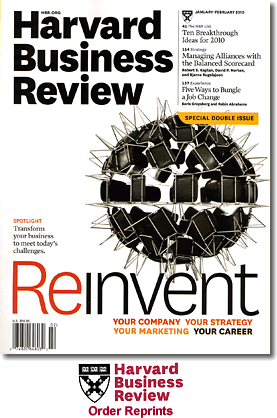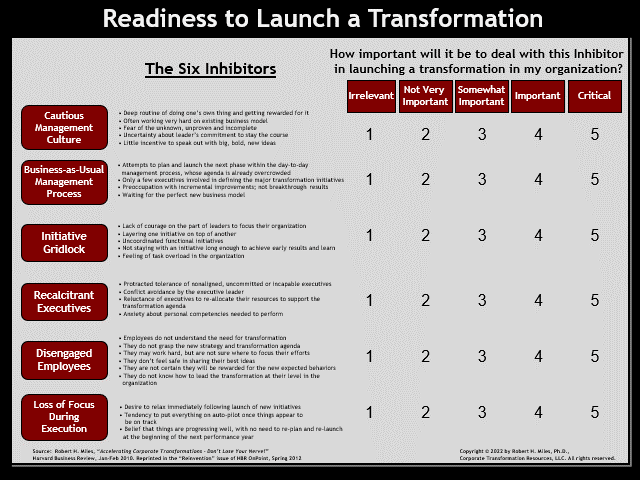 |
 In a recent Harvard Business Review article, “Accelerating Corporate Transformations-Don’t Lose Your Nerve!” six embedded transformation “inhibitors” were identified that build up in companies over time; any one of which if left unattended
by an executive leader can derail a corporate transformation launch.1
In a recent Harvard Business Review article, “Accelerating Corporate Transformations-Don’t Lose Your Nerve!” six embedded transformation “inhibitors” were identified that build up in companies over time; any one of which if left unattended
by an executive leader can derail a corporate transformation launch.1
The most important insights from our corporate transformation practices highlighted in that article are as follows:
First, transformation launches must be both bold and rapid to be successful. We live and lead in a world of highly
compressed cycle times and multiple and simultaneous distractions. Moreover, most of our employees have witnessed
many previous failed attempts and have become justifiably skeptical of each new round of heralded
change. Given all of these headwinds, leaders must be both bold and swift in launching their transformation processes.
Second, a number of “inhibitors” become built up in organizations over time, especially in those that have been
pursuing variations along the same business model.
Third, although the existence of these inhibitors can become irritating from time to time, they are relatively benign
during steady state periods in which the organization is pursuing incremental improvements along the lines of the
traditional business model. But when the time comes to transform an organization, any one of the inhibitors can
derail the whole effort if left unattended.
Finally, it is better to deal with the inhibitors in a particular sequence as the stages of transformation planning,
launch and execution unfold in an organization.
The major conclusion reached from our corporate transformation engagements was that all six inhibitors are very important in determining
the success or failure of a corporate transformation; that, indeed, overlooking any of the embedded inhibitors
by an executive leader would derail his or her transformation effort.2
 ACT was explicitly designed to enable CEOs and executives leaders to engage and overcome each of the transformation inhibitors
ACT was explicitly designed to enable CEOs and executives leaders to engage and overcome each of the transformation inhibitors
in a rapid high engagement manner.
The short readiness survey below enables you to quickly assess the extent to which you or your executive leaders will be challenged by each transformation "inhibitor" and hence, would benefit from ACT.


The bar charts on the linked page will enable you to compare your results with those of executives across a variety of industries and functions.
FOOTNOTES
- Robert H. Miles, “Accelerating Corporate Transformations-Don’t Lose Your Nerve!” Harvard Business Review,
January-February 2010, pp. 68-75; reprinted in the "Reinvention edition of HBR OnPoint, in Spring, 2012.
- For more detailed coverage of the transformation “inhibitors,” as well as the “accelerators” for overcoming
them, please refer to Robert H. Miles, Transformation Leader’s Guide: The Complete Accelerated Corporate Transformation (ACT) Method (Routledge) 2022.
- Also refer to the complementary ACT Online Course: Robert H. Miles, Transformation Leader’s Guide: The Online Course (Flevy.com) 2022.
|
 |

